Congratulations! You’ve finally decided to go all out and change your life by losing weight keeping it off. That’s a big step in the right direction, but there are many other steps to take, and some of the things you will need to do might surprise you.
Losing weight calls for changes to the foods you eat and your lifestyle, but don’t overlook your kitchen and pantry’s importance. The way your kitchen is organized, the way the food is stored, and the decor you display can all impact your weight loss journey.

Design a Kitchen That Inspires You To Cook At Home
The key ingredient to losing weight and eating a healthy diet is to cook at home regularly.
One study published in Public Health Nutrition compared people who cooked at home six or seven days each week to those who rarely cooked. Individuals who frequently made dinner at home consistently consumed fewer calories, fat, and sugar than those who rarely cooked.
Even better, the trend carried over to dining out with people who routinely cooked at home, making better choices in restaurants. What does this mean for redesigning your kitchen, though?
Start by creating a kitchen that encourages you to cook. If you love the way your kitchen looks and are comfortable with the organization, you are more likely to want to use the room. Display inspiring cookbooks or paint the walls your favorite color. You could also splurge on new pots and pans.
Whatever makes you love your kitchen and encourages you to create your own meals rather than dining out will likely pay off in a healthier diet. It can also help to have a weight loss program like Noom in your corner. This system offers tons of tools to make losing weight and getting healthier that much easier. Make sure to check out Noom‘s free trial offer that is available for a limited time.
Store Food in the Kitchen & Pantry Only
If you have a candy bowl on the coffee table, a stash of cookies in the office, or some emergency chocolate on the nightstand, you may be sabotaging your weight-loss efforts.
A scientific study published in the International Journal of Obesity found that people who stored food in multiple locations were more likely to be obese. One way to solve this problem is by confining food to the kitchen and pantry only and establishing the rest of your home as no-go zones for food.
When you don’t see food during daily activities and need to make an effort to go to the kitchen to get a snack, you are less likely to overeat.
Use Smaller Plates
If you are dishing out meals onto standard 11 or 12-inch plates, you may be accidentally overeating. As explained in one study published in the Journal of Consumer Research, the problem is a trick of the eyes.
When you serve a portion of food on a large plate, it may not look like you are eating much. On the other hand, if you serve the same potion on a smaller plate, your eyes and brain will perceive the amount of food as a large helping. As you are redesigning and reorganizing your kitchen, pack away the largest plates, so you aren’t tempted to serve meals on them.
Instead, pull out the smaller plates, which are often reserved for appetizers or desserts. With those often-overlooked plates in frequent rotation, you will likely feel more satisfied with appropriate servings at mealtimes.
Use Larger Forks
We know this one seems at odds with the tip to use smaller plates, but when it comes to forks, size matters in a different way. More studies published in Appetite compared the amount of food people consumed when using a large fork or a small fork.
Surprisingly, people ate less when using a large fork. The reason is another trick that your eyes can play on your appetite when eating with this kind of utensil.
When taking a large bite, your eyes see the progress you are making toward finishing the food on your plate. As a result, you may feel that you have consumed ample food and should stop eating.
As such, it can be helpful to pack away your small forks along with the large plates. With your cabinets filled with only small plates and large forks, you are set to control your portion sizes and to enlist the help of your eyes in controlling what you eat at mealtime.
Load Your Pantry With Healthy, Pre-Portioned Snacks
When you need a quick bite, it is too easy to grab too much of the wrong food. This is where stocking your pantry with pre-portioned snacks can help you a lot.
People who were given snacks in individual portions consumed fewer calories than those who ate from standard-sized packages. At the beginning of your weight-loss journey, it can be challenging to judge portion sizes, so items that come in individual portions can make the learning process easier and more convenient.
As you become more accustomed to eating proper portions, you may be able to return to using standard-sized packages with occasional check-ins to ensure you are still on track.
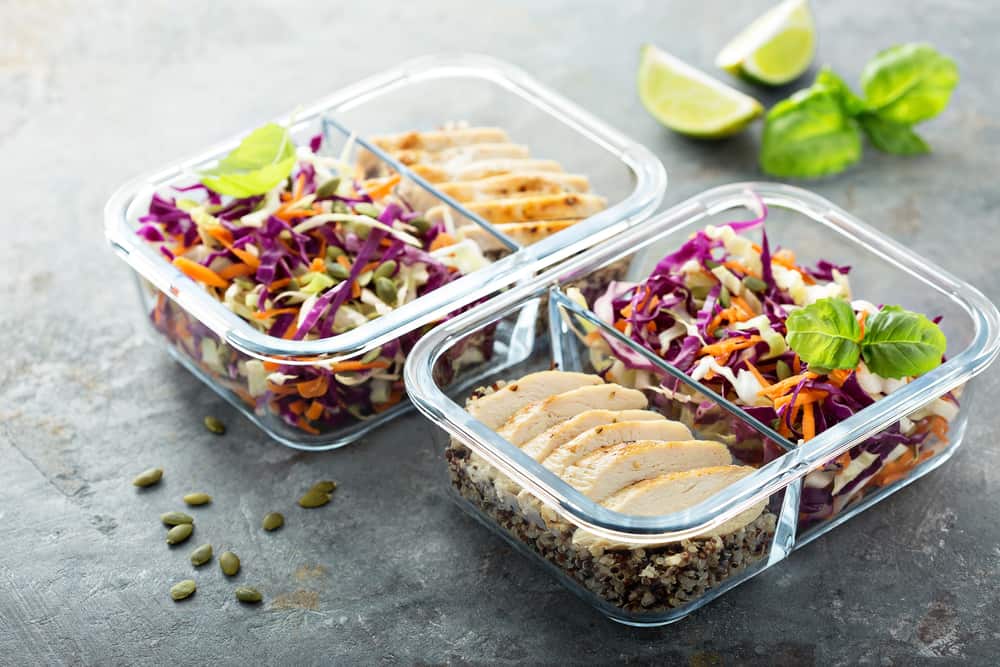
Stock Up on Portion-Sized Containers
The previously mentioned study published in Appetite may have focused on pre-portioned snack packs, but you can use the same principles to create your own portioned snacks as well.
You can start by purchasing snack-sized resealable bags and small reusable containers. Spend a few minutes on the weekend measuring out and repackaging your favorite healthy snacks. Make sure to store your homemade pre-portioned snacks prominently in your pantry and refrigerator to make them easier to access and choose over other foods in your home.
When you have the right tools and containers on hand and spend a little time to measure out proper portions, you can snack guilt-free all week without worrying about exceeding your calorie allowance or relying on expensive snack packs.
Clear the Counters
Clean counters can lead to clean eating, according to a study from Health Education and Behavior.
If you have a small kitchen, or if you like to keep the commonly-used foods within easy reach, you may be tempted to store food directly on the kitchen counter. However, this can be pretty risky to your diet. While you are reorganizing your kitchen, give the counters a clean sweep. Common culprits here may include breakfast cereal, soda, candy, cookies and candy, and bulky items.
Oversized boxes can be tricky to store, which leads to leaving them out, but leaving high-calorie or unhealthy items on the counter can lead to overeating. In this case, try to purchase smaller amounts of the product, or invest in some hidden storage shelves where you can keep these kinds of items.
Keep Fruit on The Counter
The one exception to keeping food on the kitchen counter is fruit. Not only will a bowl of apple, bananas, and pears look lovely on your kitchen counter, but displaying fruit can also encourage you to skip unhealthy treats, and to make better food choices.
The same study published in Health Education & Behavior mentioned before also found that people who keep fruit on their countertops have a lower Body Mass Index. When fruit is easy to pick up, you are more likely to opt for it simply because it is visible and easily accessible.
It is important not to push the fruit bowl back into a forgotten corner of your cabinet. Choose a pretty bowl and place it front-and-center in the highest traffic spot in your kitchen. Displaying fruit in something beautiful will make it feel like a really special treat. Overall, the more visible fruit is, the less likely you are to forget about it and the more likely you are to make a healthy food choice.
Stow Treats Out of Sight & Highlight Healthy Options
While you are cleaning off the kitchen counters and placing a bowl of fruit in a prominent area, it can also be a good idea to hide the treats and other less-than-healthy food choices.
Studies, particularly one published in PLoS One, have shown that proximity heavily influences food choices. In other words, if you can see it, you are more likely to eat it. If you need to keep sugary snacks, high-fat foods, or sodas in the home, it is best to hide them from yourself.
Try stowing unhealthy items in the back of cabinets, at the top of the pantry, or behind healthier options. If you can not see these unhealthy options and need to work to get to them, you are less likely to eat foods that could derail your nutrition plan.
If you forget to use unhealthy items in the best-case scenario, you may not need to purchase them in the future. On the flip side, placing healthy options at eye level at the front of your pantry where they are easy to see and access can make these healthier foods a regular part of your diet.
Having a comprehensive program like Noom in place can also help you stay within your caloric limit. This program offers tons of tools, like custom meal plans, food logging, 1:! health coaching, and so much more. If you are ready to try Noom out for yourself, make sure to check out their Noom.
Keep Water in View and Easy to Access
It is well known and backed up by science, particularly one published in Frontiers in Nutrition, that drinking water can help you lose weight. Adequate hydration helps you feel full so that you are less likely to overeat.
How can you set yourself up for success when it comes to drinking water throughout the day? Just as with so many methods for reorganizing your kitchen for weight loss, it is all about visibility and easy access. If you use a water cooler, place it in your kitchen area with the highest traffic.
You could also select a brightly-colored water bottle that speaks to your personality. Fill it up in the morning and keep it with you throughout the day. When not in use, place your water bottle in the center of your kitchen island or on the counter so that you will see it each time you enter the kitchen. This can act as a reminder to fill it up and take a sip.
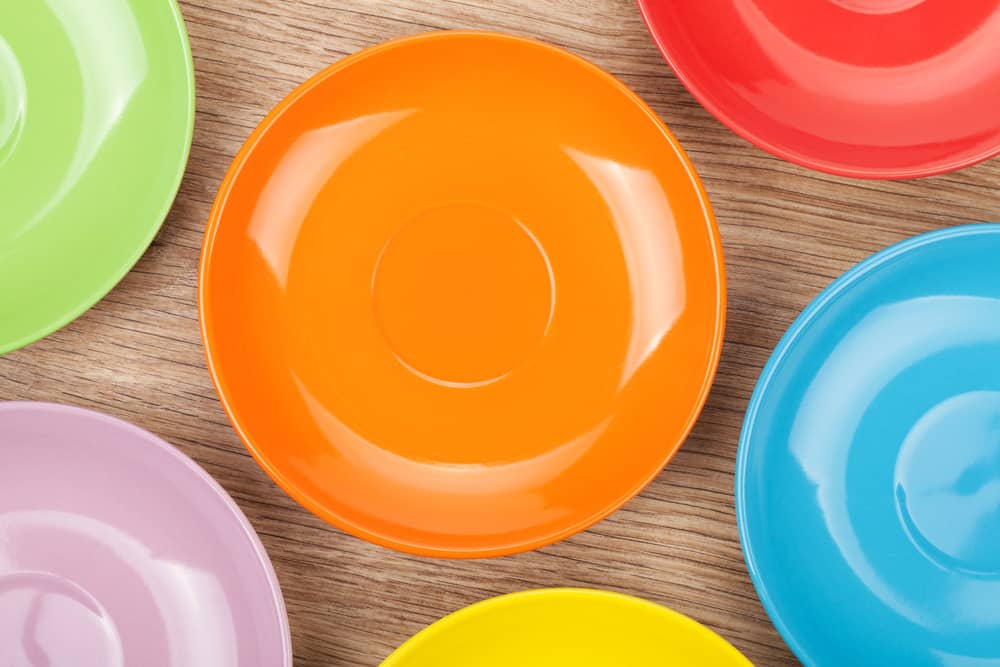
Use Colorful Plates
Bright, colorful plates can be a fun way to bring extra joy to mealtimes. What’s not to love about that?
Even more, there is a more scientific reason for choosing plates in a mixture of bright hues. According to the Journal of Consumer Research, contrast is an important part of understanding portion size. If food blends into a similar color plate, it is easier to misjudge the amount you are consuming and overindulge.
This could come into play when using white plates for starchy foods, such as bread or potatoes. Instead, fill your cabinet with small plates and bowls in bold patterns or a range of colors that allow food to pop visually. As a result, your meals will be instantly exciting and visually appealing, and you may eat less due to the distinguished portion on your plate.
If you already have dinnerware you love, consider adding contrast by using bold tablecloths. As an added benefit, bringing in your favorite shades is a good way to work toward the larger goal of creating a kitchen that inspires you to cook at home.
Establish the Stove As a Serving Station
Do you have a collection of oversized platters and beautiful serving bowls? Now may be the time to pack those away.
Setting the table and sitting down to meals around a table full of food may be a family dinner tradition, but it could also be encouraging overeating. Rather than filling plates at the table, serve food at the stove or near the oven.
According to a study from Cornell Food and Brand Lab, this trick could help women eat up to 20% fewer calories. Likewise, men who filled their plates at the stove rather than at the table consume around 29% fewer calories. This is another example of the out-of-sight-out-of-mind principle.
When platters of extra food are in front of you at the table, it is easy to reach for another serving. However, if you need to walk from the dining area to the kitchen for a second helping, you are more likely to be satisfied with a single portion.
Once the meal is done, return to the kitchen, immediately wash your plate, and put it away to avoid the temptation of eating just a bit more. Then, pack away leftovers in individual portions for healthy lunches or dinners later in the week.
Make the Dining Table a Tech-Free Zone
You likely spend a great deal of your deal looking at your phone or a computer screen. However, much of that time is likely in service of work or school.
When you finally have time to sit and eat, it may be tempting to scroll through your social media feeds, catch up with what is on the news, or message friends and family. However, all of those activities are distracting and take your attention away from your meal.
A recent study published in The American Journal of Clinical Nutrition has shown that distractions, such as phones and tablets, at the dining table can lead to overeating. Establish your dining table as a tech-free zone and leave all of your phones and other devices in another room.
Without technology at the table, you will be better able to direct your attention to eating appropriate portions and enjoying each bite.
Ban Television At the Dining Table
Plopping down in front of the television at the end of a long day is tempting, but it is a definite no-go at mealtimes. One study published in JAMA Internal Medicine has shown that adults and children who watch television during meals have a higher Body Mass Index.
Watching television during meals could be a driver for overeating, especially if you are binging action-packed content or shows that are overly loud. Just as with tech devices, the reason for the correlation between television watching and overeating could be a distraction, but there may be another reason at play. The stimulation, anxiety, and agitation which results from watching action-packed content could also encourage overeating.
Whatever the cause, when you redesign your kitchen as part of your weight loss efforts, replace television watching with a renewed focus on conversation and attention to your meal.
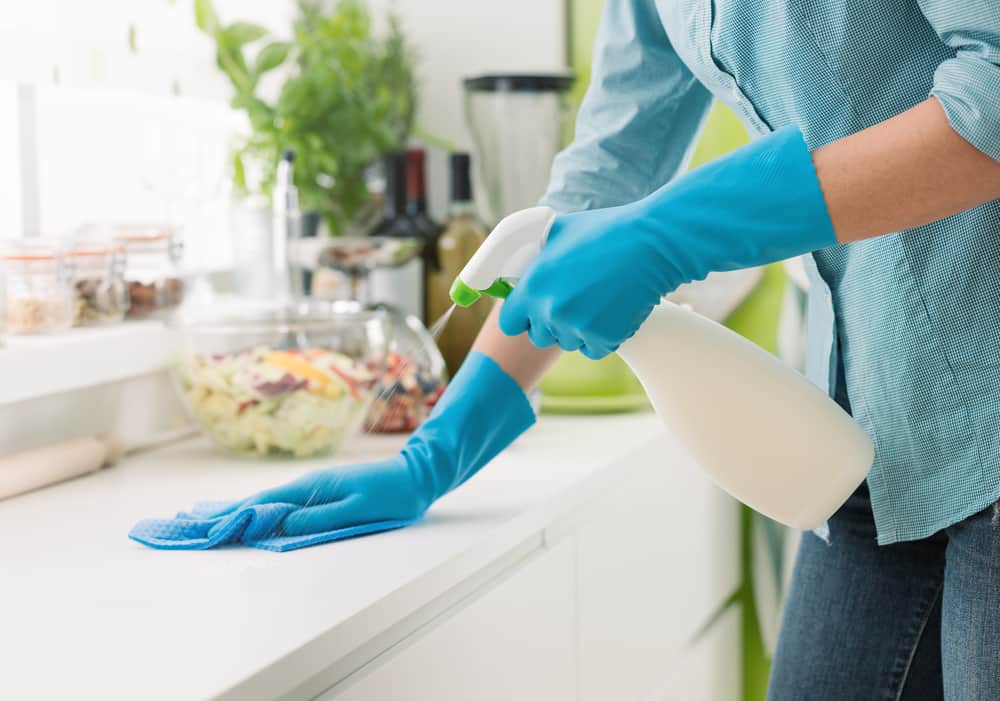
Clear Out Clutter
Overflowing drawers of gadgets, a refrigerator front full of children’s art, mail on the counter, and plastic baggies and aluminum foil rolls sneaking out of their space all add up to a messy kitchen.
Research published in Environment and Behavior has found that messy kitchens lead to excess snacking, which means it is time to cut the clutter. A messy kitchen filled with too many things can feel chaotic. If your kitchen feels out of control, your diet will likely follow.
As you are reorganizing your kitchen to aid in your weight loss efforts, a hardcore purge may be in order. The countertops are a good place to start, but the drawers and cabinets should quickly follow.
Start by decluttering every area and getting rid of anything that is broken, does not work well, or that is rarely used. Then, create zones and set up a kitchen workflow that matches your cooking style. Ensure that everything is well organized and easy to both find and put away. Most importantly, eliminate any visual clutter that feels stressful to you.
The idea is to create a calm, relaxing room that doesn’t make you reach for snacks and that inspires you to cook healthy meals.
Play Soft Music in the Kitchen
Have you ever noticed the soft tinkle of music in the background of luxurious restaurants and shops? Marketers know that soft music helps to create a relaxed environment.
Steal a bit of that expertise for your own kitchen by playing soft tunes as you prepare meals. Just like eliminating visual clutter, listening to light background music is a good way to create a calm environment and has been shown to encourage healthy food choices.
A recent study published in the Journal of the Academy of Marketing Sciences compared environments with soft music and those with loud music and found that the calmer environment resulted in healthier food choices.
Keep the Dining Room Quiet
While soft music can create a relaxed environment, the dining room should never be noisy. Why? If you have ever craved a crunchy snack, you know how satisfying the sound of chewing can be.
More often than not, we think about taste and sight as the major sensory experiences with food. However, sound is an often overlooked part of mealtimes.
According to one study published in Food Quality and Preference, you are likely to eat less when you can hear yourself eating. When you can hear the sound your food makes in your mouth, you are more likely to feel satisfied and be more aware of the amount you are consuming.
So, turn down the volume, keep the extraneous noises in the dining area at a minimum, and enjoy the sound of your own chewing to help set the stage for successful weight loss.
Nix Oversized Tumblers
Are oversized tumblers and large cups spilling out of your cabinets? Big, plastic drinkware are a common source of kitchen clutter and they could be encouraging you to overdo it with high-calorie drinks.
In a recent study published in BMJ, college students were asked to pour one shot (or 1.5 ounces) in both a short, wide glass and a tall, slim glass. During the study, even experience bartenders, who pour drinks for a living, misjudged the amounts. On average, participants poured 20.5% more liquid into the short, wide glasses.
So, what does this mean for your kitchen? Getting rid of bulky cups and exchanging them for slim glasses could help you drink less of all sorts of high-calorie beverages. While the study focused on alcohol, you can carry over the advice to other drinks, such as juice, soda, or flavored water. It is also a good idea to commit to one type of glass.
When you use identical glasses each time you pour a drink, the way the serving size looks will be consistent, and you will be better able to pour the right amount every time. If you want to feel really fancy, ditch all the plastic and opt for glass drinkware or even champagne glasses. The elevated experience could give you another push to drink less as well.
Keeping track of your portions can be that much easier when you have a health program like Noom in place. We like this program because it offers tons of psychology-backed tactics to help users lose weight and keep it off. Make sure to check out the free trial offer from Noom to learn more!
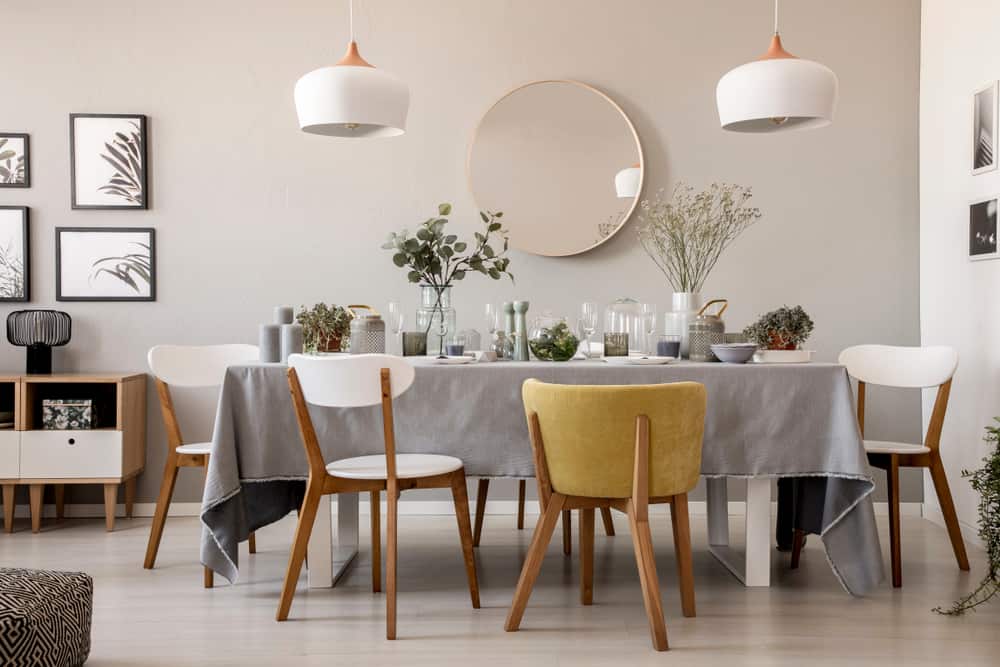
Hang a Mirror in the Dining Area
While you are creating an inspiring kitchen and a dining area that you love, you will likely need to add some wall décor. Rather than adding artwork, opt for a large mirror near the dining table. A mirror will add light and help to make the room a welcoming space that you want to eat your meals in.
While mirrors in dining areas have long been a popular design choice, there is another side to this trick that you may not have thought about. According to one study published in the Journal of Applied Psychology, a mirror can bring in an element of self-awareness that can be helpful in your weight-loss journey. Being able to see your reflection may discourage you from eating certain foods.
The study showed that people were less likely the eat full-fat and high-calorie foods when there was a mirror nearby. Even better, the study’s participants remained willing to eat reduced or no-fat foods. In your home, this means that you may be more willing to make healthy choices if you can see yourself while you are eating.
Use Lidded, Opaque Bowls for High-Calorie Foods
We have discussed the importance of putting healthy choices front and center and hiding less healthy options. Another way to do this is to invest in a set of opaque bowls with lids, as well as other opaque storage containers.
A recent study published in the International Journal of Obesity (London) found that people were less likely to eat chocolates that were stored in opaque bowls than the same candies in a clear bowl. In your kitchen, you can use this to hide desserts, cookies, and candy.
Don’t overlook high-calorie leftovers, or restaurant meals brought home in plastic bags either. Since the whole family might not follow the same dietary restrictions or calorie guidelines, this strategy can help keep treats and favorite foods available, without allowing them to scream for your attention.
Add a Spice Cabinet and Keep it Stocked
Adding spices can make lower fat food tastier. In fact, recent studies from the Institute of Food Technologists have shown that people rated low-fat food flavored with herbs and spices just as highly as the full-fat version with no spices.
As an added bonus, when the healthy, reduced-fat versions of your favorite meal taste better, you won’t go running back to the full-fat version next time. This can be especially helpful for hearty meals and family favorites such as pasta in cream sauce and meatloaf.
Even basic vegetables can be amped up with dried herbs and spices, which means you will be less likely to add a pat of butter to a side of roasted potatoes and carrots.
Of course, the best way to remind yourself to use your favorite herbs and spices is to keep them front and center in your kitchen. Dedicate some of your freshly decluttered counter space to a spice rack and fill it with clearly-labeled jars.
Add Canned Beans, Lentils, or Chickpeas To Your Pantry
What you put in your pantry is just as important as how you organize the space. While rearranging your kitchen and pantry, be sure to reserve space for beans, lentils, and chickpeas. In both dried and canned versions, incorporating these foods can be an important part of losing weight.
A study published in the American Journal of Clinical Nutrition showed that people who ate diets rich in peas, beans and lentils were able to lose weight and reduce their body fat percentage in a way that participants who skipped these foods did not. Plus, the results held up even when the participants did not significantly reduce the number of calories they consumed, making this tip an easy win.
Even more, beans and lentils are high in protein and are easy to incorporate into many recipes, and are quick to cook for an easy meal on a busy schedule, all of which will make these foods the stars of your kitchen makeover.

Keep a Notepad & Pen Handy
One effective use of your recently-cleared counter space is a notepad and pen for jotting down your grocery shopping list.
According to one study published in the Journal of Consumer Behavior, shopping with a list in hand leads to fewer groceries. When you walk into the store with a detailed list of the items you intend to purchase, you’ll likely be less tempted by impulse purchases.
Plus, since you are more likely to impulse purchase a package of cookies than a bag of spinach, sticking to a list can make an impact on the nutritional content of what you end up eating. While an old-fashioned pencil and paper solution might be the most streamlined choice, a digital assistant such as an Amazon Alexa or Google Home that you can dictate your shopping list to is also a handy addition to your kitchen.
Just tell your device what you need to purchase, and you will be able to see the list on your smartphone later. Even better, a digital assistant, like Noom can make other kitchen tasks, such as converting measurements or looking up recipes, easier. If you want to try the other tools offered by Noom, make sure to check out their free trial offer.
Add Pops of Red
You probably don’t want to add a literal stop sign to your home, but a few flashes of red in your kitchen and dining room might send the same message. In a recent study, people who were served snack foods on red plates ate less than those who used blue or white plates.
It makes sense that the bold color would help you put the brakes on eating since red is well-known as the color of danger, sirens and negativity. However, if you don’t want to replace your plates, there are plenty of other ways to add red to your kitchen and dining space. Cloth napkins, or a tablecloth, could be effective accessories.
If you think you are ready for a little more commitment (or think a larger stop sign might help), get out your paintbrush and add an accent wall behind the dining table.
Get a Teapot
If you are up for adding a new kitchen gadget and can spare a bit of cabinet or counter space without creating clutter, pick up a teapot.
Green tea has been shown in The Cochrane Database of Systemic Reviews to aid in weight loss and weight maintenance, especially in overweight adults.
Likewise, black teas have been shown to have a similar impact in one study published in Molecules. Not only can tea help control weight, but tea can also serve as a craving-curbing pick-me-up. Overall, a pretty teapot, which inspires you to make a cup of tea, can be a valuable tool in your weight loss plan.
Stock up on Healthy Breakfast Options
While you are decluttering your kitchen and setting up organizational zones, create a breakfast area with easy-to-prepare and healthy morning staples.
Studies, particularly one published in The Journal of Adolescent Health, have shown that skipping breakfast is associated with weight gain, especially for adolescents as they transition into adulthood. Commonly, mornings can be chaotic, though, and it is tempting to cut breakfast from the schedule in favor of getting to work and school on time.
Set up your kitchen to make breakfast an easy, stress-free, and essential part of the morning for the whole family. Store oats or high-fiber, low-sugar cereals in clear storage containers with bowls and spoons nearby. Alternatively, you can keep pre-portion servings of yogurt and fresh fruits in clear, lidded containers to store on an eye-level shelf in the refrigerator.
When healthy breakfast options are visible and easy to prepare, you are less likely to skip this important meal and less likely to resort to fast food or high-calorie foods later in the day.
Keep a Weight Loss Journal in the Kitchen
Writing down everything you eat probably doesn’t sound like a lot of fun, but it is an essential part of losing weight. Science has shown that self-monitoring is a centerpiece in changing eating habits, cutting calories, and reducing weight.
Start each morning by jotting down everything that you eat or drink and continue throughout the day. On a day-by-day basis, writing down your intake may prevent you from overeating or making an unhealthy food choice. Over weeks and months, you may see patterns and find the times of the day or other triggers that lead to overeating.
In both the long and short terms, a food log is another tool in your weight loss journey. It is important to remember that keeping a food journal is only helpful if you are consistent, which means it needs to be easy and visible when you prepare and eat food.
Select a notepad or journal and place it prominently in your kitchen. Alternatively, you can place a blank page on your refrigerator door each morning, add notes to it throughout the day, and transfer to a complete log later.
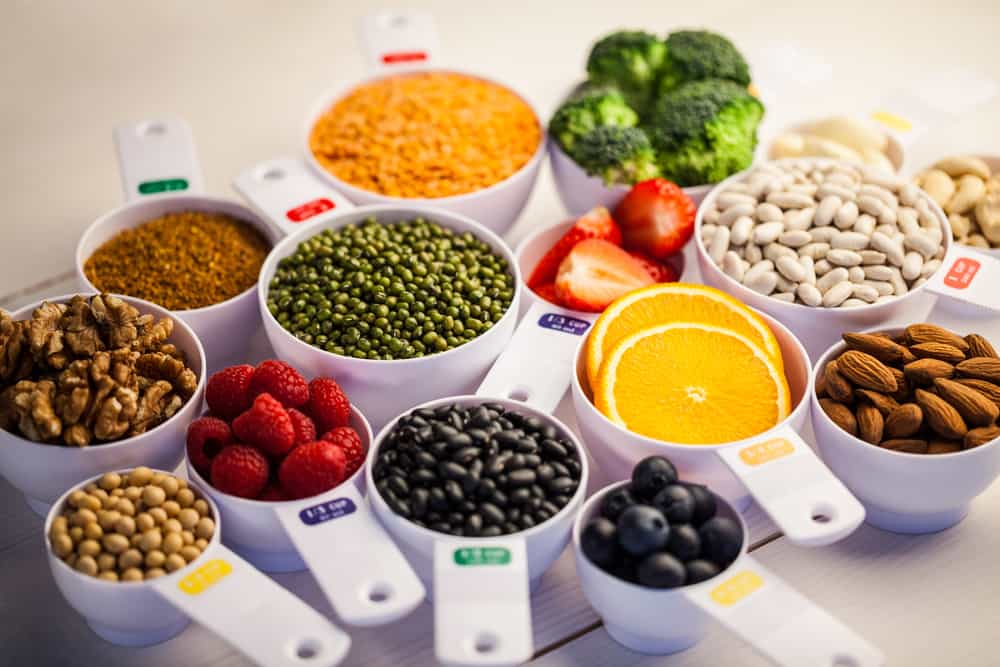
Add Measuring Devices to Your Kitchen Devices
Choosing healthy foods is an important part of weight loss, but science published in Critical Reviews in Food Science and Nutrition shows that portion control is also crucial. Rather than leaving things to chance or eyeballing portions, add a range of measuring devices to your kitchen collection.
Just as importantly, place measuring devices where they will be readily used. Rather than relying on one set of measuring spoons, pick up a few inexpensive sets. Check nutrition labels and place corresponding tablespoons or scoops in food containers, focusing on snack containers. This way, you can quickly measure out exactly one portion without searching for a measuring spoon.
A kitchen scale is also helpful for weighting protein portions at mealtimes. As you measure out portions for snacks and meals, be sure to add the amounts to your food log.
Add Soft, Ambient Lighting
Infusing your kitchen with soft, ambient lighting may set a romantic mood, but there is a more important reason that you should consider lighting as part of your kitchen redesign.
A recent study published in Psychological Reports has shown that soft light in a dining area may lead you to eat less and to enjoy your food more. The way this trick works is similar to playing soft music in the background in that it provides a sense of relaxation.
This is something that restaurants have incorporated into their designs for decades. To make this work at home, replace lightbulbs in the dining area with lower watt options, or install dimmer switches that allow you to customize the lighting. You could also bring in lamps and switch off harsh overhead lights.
Changing just one of these things about your kitchen can make a big difference in helping you reach your weight loss goals. The more of them you can factor into your kitchen overhaul, the greater your chances of success.
You can also overhaul your health and weight-loss goals with a program like Noom. This program has been proven in multiple clinical studies to help users lose weight and adopt healthier habits. If you are ready to try out Noom for yourself, make sure to check out their free trial offer.
Article Sources
- https://www.cambridge.org/core/journals/public-health-nutrition/article/is-cooking-at-home-associated-with-better-diet-quality-or-weightloss-intention/B2C8C168FFA377DD2880A217DB6AF26F
- https://noom.8utb.net/c/1720052/500038/8591
- https://noom.8utb.net/c/1720052/500038/8591
- https://www.nature.com/articles/ijo201570
- https://academic.oup.com/jcr/article/39/2/215/1795747
- https://www.ncbi.nlm.nih.gov/pmc/articles/PMC4441264/
- https://journals.sagepub.com/doi/10.1177/1090198115610571
- https://pubmed.ncbi.nlm.nih.gov/24367684/
- https://noom.8utb.net/c/1720052/500038/8591
- https://www.frontiersin.org/articles/10.3389/fnut.2016.00018/full
- https://academic.oup.com/jcr/article/39/2/215/1795747
- https://www.eurekalert.org/pub_releases/2010-04/cfb-nst042610.php
- https://academic.oup.com/ajcn/article/97/4/728/4577025?login=true
- https://jamanetwork.com/journals/jamainternalmedicine/fullarticle/1899554
- https://journals.sagepub.com/doi/abs/10.1177/0013916516628178
- https://link.springer.com/article/10.1007%2Fs11747-018-0583-8
- https://www.sciencedirect.com/science/article/abs/pii/S0950329316300271
- https://www.ncbi.nlm.nih.gov/pmc/articles/PMC1322248/
- https://noom.8utb.net/c/1720052/500038/8591
- https://noom.8utb.net/c/1720052/500038/8591
- https://pubmed.ncbi.nlm.nih.gov/9885199/
- https://pubmed.ncbi.nlm.nih.gov/16418755/
- https://www.sciencedaily.com/releases/2013/07/130715134640.htm
- https://onlinelibrary.wiley.com/doi/full/10.1002/cb.1812?casa_token=vlnXBcbgveAAAAAA%3Add2Lgeg0qJy03gFpiztyCc9gzXTi2X8Tw4XZUVpytw-jqAhM8T2ZgdJ2cLvUL2DfN9YjUMvFJpLXkw
- https://noom.8utb.net/c/1720052/500038/8591
- https://noom.8utb.net/c/1720052/500038/8591
- https://pubmed.ncbi.nlm.nih.gov/23235664/
- https://pubmed.ncbi.nlm.nih.gov/27941615/
- https://pubmed.ncbi.nlm.nih.gov/17116514/
- https://www.ncbi.nlm.nih.gov/pmc/articles/PMC4337741/
- https://journals.sagepub.com/doi/abs/10.2466/01.PR0.111.4.228-232
- https://noom.8utb.net/c/1720052/500038/8591
- https://noom.8utb.net/c/1720052/500038/8591
Partner with Us!
Looking to promote your weight-loss products or services?
Our platform reaches a dedicated audience actively seeking the best solutions. Contact us to explore advertising opportunities and grow your brand with us.
Get in Touch
